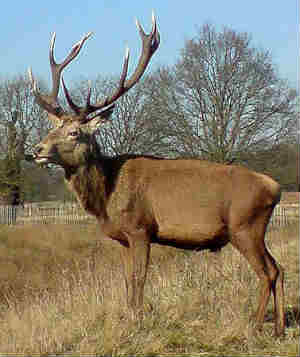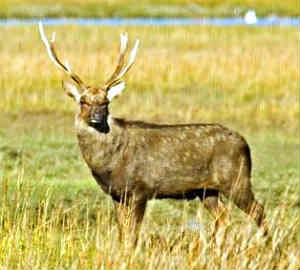Red Deer × Sika
Mammalian Hybrids
EUGENE M. MCCARTHY, PHD GENETICS, ΦΒΚ

|
|
Red Deer (Cervus elaphus) |

|
|
Sika Deer (Cervus nippon) |
Natural hybridization between red deer and sika occurs in many locales (Ireland, Britain, Europe, New Zealand and eastern Asia). Many such hybrids have also been produced in captivity. The hybrids are fertile in both sexes.
These hybrids are intermediate in size between red deer and sika, but resemble sika more, especially the antlers and tail. In summer their fur is spotted (yellow, not white), but the spots are less sharply defined than in sikas. Backcross hybrids are hard to tell from whichever pure type the backcross occurs to. C. elaphus hinds seem to be too large for a C. nippon stag to mount. However, Harrington (1973, p. 75) says, “the height difference is overcome by the ability of the red deer hind to accommodate herself to the shorter stag by bending her legs.” The reciprocal cross seems to be inhibited by behavioral incompatibilities, but has been produced under controlled conditions.
Wyman et al. (2011) note that "observations of sika and red deer interactions in areas where both species are present suggest that some male sika deer may gain closer access to female red deer by ‘sneaking’ into red deer harems without incurring active aggression by harem-holding male red deer.” The hybrid of a sika doe with a C. elaphus male is called as silk deer (= sika + elk).
Contact and hybridization between red deer and sika is natural in eastern Asia, but sika deer have been introduced elsewhere and therefore interbreed C. elaphusin those regions through human intervention. Levels of hybridization can be intense. Indeed, hybridization of this type is so extensive in Europe that it's considered a threat to Cervus elaphus there. The IUCN says,
Sika were repeatedly introduced to Britain and Ireland from 1860 to 1930, particularly by Viscount Powerscourt, who knew they readily hybridized with red deer, and sika quickly became part of the naturalized fauna (Lever 1977). Natural hybridization now occurs on both these islands. Harrington (1973, p. 70) says that among 200 deer observed in County Wicklow, Ireland 50-60% were obvious hybrids, “10% were mostly red-deer-like and 30% were very sika-deer-like” and (p. 76) that hybridization with the introduced sika has “led to the almost complete destruction of the genetic integrity of red deer in Britain and Ireland.” Goodman et al. found that 40% of the deer near Argyll, Scotland that looked like red deer had an admixture of sika DNA and concluded pure red deer would essentially cease to exist in that region. Here's a video of red deer/sika hybrids in Ireland:
Hybridization is also widespread on the European continent. For example, in a Czechoslovakian survey Bartoš and Žirovnický found hybrids in all sampled populations. And it also occurs extensively in New Zealand where these deer have both been introduced (Davidson 1973; Kiddie 1962).
One might suppose that such hybridization would not have occurred without human intervention, but in eastern and northern Asia where the natural ranges of these deer meet, human activities seem to have reduced hybridization below former levels. Thus, Hepner et al. (1988, p. 135) note that “formerly, when sika deer were abundant in the taiga, such hybrids were found so frequently in nature that they had a special Chinese name.” This hybridization occurs in the Ussuri Valley (Russo-Manchurian border region).
Bartoš et al. (1981, p. 260) say that the first European explorers to see the natural hybrids described them as a subspecies of C. nippon (a seemingly common practice of naturalists when first encountering a natural hybrid). Indeed, Lowe and Gardiner 1975 (p. 564) say that the mainland forms of C. nippon (e.g., hortulorum, kopschi, and mantchuricus) “may well be the products of hybridization between Japanese Sika and Chinese Wapiti [= Chinese red deer]” (since they are similar to known hybrids with dominant sika characters).
Are we hybrids? Many facts suggest it's true!

|
References: Abernethy 1994; Antonius 1951b; Bartoš and Žirovnický 1981; Bartoš et al. 1981; Blair 1972; Bromley 1956; Brook 1898; Delap 1967, 1968; Flerov 1952; Feldhamer 1980; Goodman et al. 1999; Harrington 1973, 1982; Heptner et al. 1988 (pp. 135-136); Kiddie 1962; Long et al. 1998; Lowe 1961; Koubek and Zima 1999; Lowe and Gardiner 1975†; McNally 1969; Mirolyubov 1948; Moffat 1938; Powerscourt (Viscount) 1884 (p. 209); Rocholl 1967; Salganskii 1963; Sarkisov 1944 (cited by Sokolov 1959); Senn and Pemberton 2009; Wettstein 1931†; Whitehead 1964. Internet Citations: MAPM.
Most shared on Macroevolution.net:
Human Origins: Are we hybrids?
On the Origins of New Forms of Life
Mammalian Hybrids
Cat-rabbit Hybrids: Fact or fiction?
Famous Biologists
Dog-cow Hybrids
Georges Cuvier: A Biography
Prothero: A Rebuttal
Branches of Biology
Dog-fox Hybrids